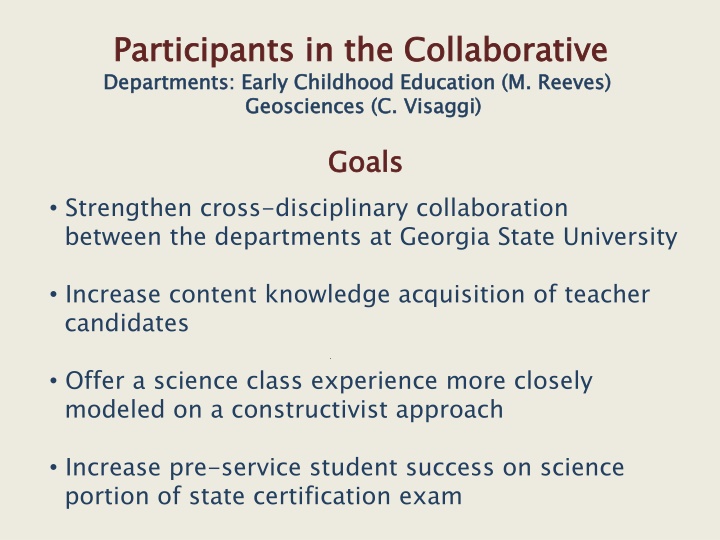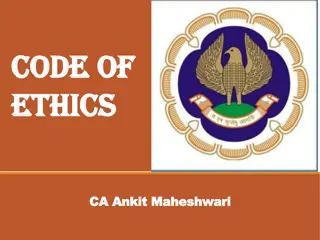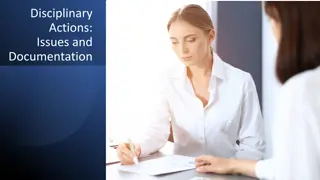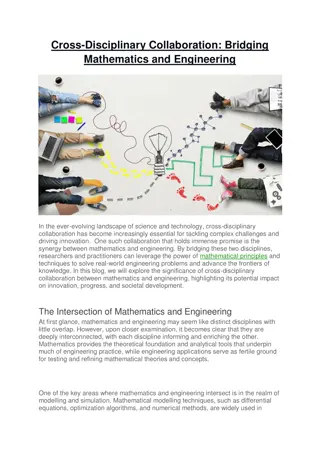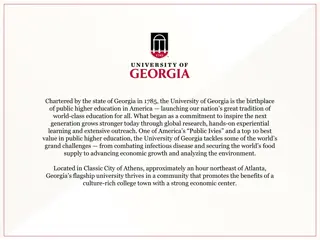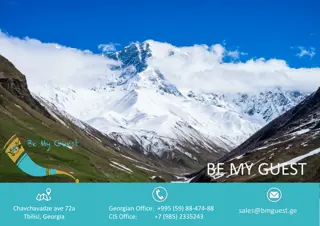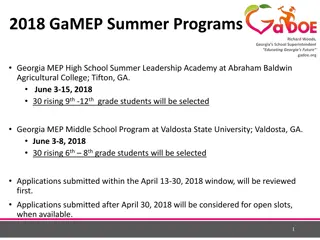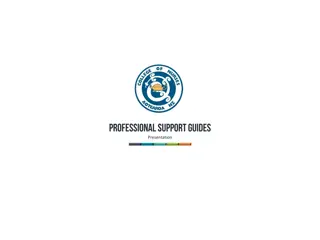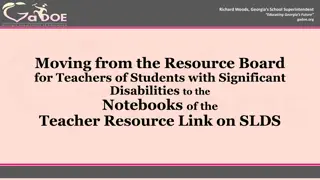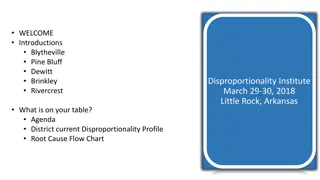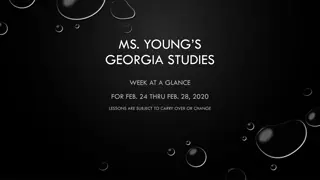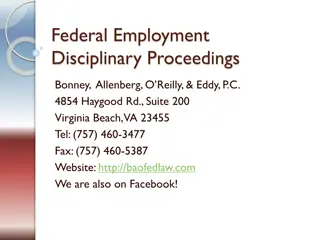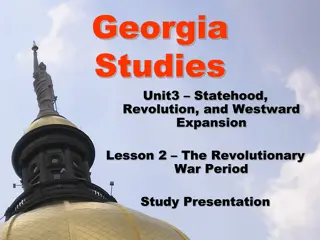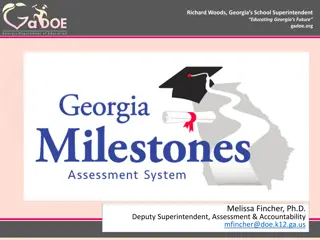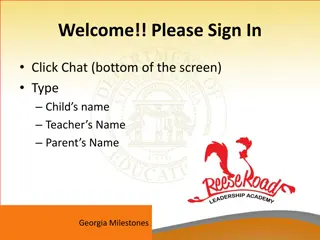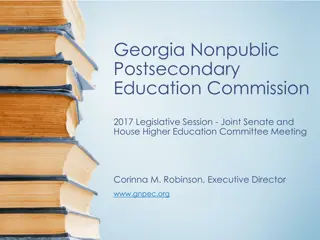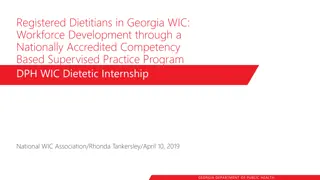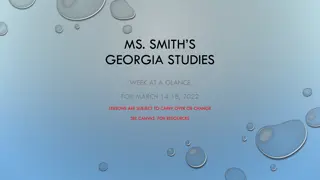Cross-Disciplinary Collaboration in Science Education at Georgia State University
Strengthening cross-disciplinary collaboration between Early Childhood Education and Geosciences departments at Georgia State University. The goal is to enhance content knowledge acquisition for teacher candidates through a constructivist approach. The curriculum includes topics related to Earth science, biology, evolution, and human impact on natural processes. Activities, presentations, and group rotations facilitate student engagement and learning, ultimately aiming to improve pre-service student success on science certification exams.
Download Presentation

Please find below an Image/Link to download the presentation.
The content on the website is provided AS IS for your information and personal use only. It may not be sold, licensed, or shared on other websites without obtaining consent from the author.If you encounter any issues during the download, it is possible that the publisher has removed the file from their server.
You are allowed to download the files provided on this website for personal or commercial use, subject to the condition that they are used lawfully. All files are the property of their respective owners.
The content on the website is provided AS IS for your information and personal use only. It may not be sold, licensed, or shared on other websites without obtaining consent from the author.
E N D
Presentation Transcript
Participants in the Collaborative Departments: Early Childhood Education (M. Reeves) Participants in the Collaborative Departments: Early Childhood Education (M. Reeves) Geosciences (C. Visaggi) Geosciences (C. Visaggi) Goals Goals Strengthen cross-disciplinary collaboration between the departments at Georgia State University Increase content knowledge acquisition of teacher candidates Offer a science class experience more closely modeled on a constructivist approach Increase pre-service student success on science portion of state certification exam
Content Sequencing Content Sequencing Characteristics of Life & Geology Principles Formation Earth/Moon Weather and Climate Cells and Organelles Biochemistry Biological Classification Mineral Classification Plate Tectonics Rock Cycle Food Webs Energy Relationships and Cycles Weathering and Soils Biomes Absolute and Relative Dating DNA Mitosis Meiosis and Genetics Deep Time and Fossils Principles of Evolution History of Life Comparative Biological Principles Geology and Biology of Georgia Human Impact on Natural Processes Biomes Human Impact on Natural Processes
In In- -class Time Use class Time Use Student Student Work Work Days 22 Days 22 Activities designed by instructors of the collaborative 10 Geology 11 Biology (2 outside class assignments) 2 Biology/Geology Activities designed by instructors of the collaborative 4 4 Student presentations Biome presentations Human Impact on Natural Processes presentations Orientation to the course Test Student presentations 1 1 2 2 Orientation to the course Test
First Day! First Day! Living vs. Non-Living Characteristics of Life Characteristics of Earth Earth System
Group Rotations Group Rotations Sam * Kelsi # Jasmine Kaila # Nadia Ashley # Kaela * Christina Arielle Riley # Diana * Alexis Tony Taylor * Kia # Eva *# Hui* Kyara # Kristen * Jessica Gia *# Joy # Cassie Alex Elesha # Deana * Hillary # Janelle * Diana * Deana * Ashley # Alex Hui * Kaila # Joy # Nadia Sam * Kia # Elesha # Jessica Kristen * Kelsi # Hillary # Arielle Cassie * Eva *# Jasmine Alexis Taylor * Janelle * Kyara # Christina Kaela * Riley # Gia *# Tony Riley # Kyara # Kaela * Arielle Eva *# Sam * Deana * Alexis Ashley # Hillary # Taylor * Christina Kelsi # Diana * Cassie * Jasmine Joy # Elesha # Kristen * Tony Kaila # Hui * Nadia Alex Kia # Gia *# Janelle * Jessica Symbols denote prior college coursework in different STEM fields. Each class rotation (A, B, C) has a mixed set of experts in these varied STEM fields.
Early Course Student Response Early Course Student Response
Grades as a Measure of Success Grade Structure Daily Average Grades as a Measure of Success Grade Structure 2 tests = 30% Comprehensive exam = 20% Homework = 20% Class Presentations = 30% 2 tests = 30% Comprehensive exam = 20% Homework = 20% Class Presentations = 30% Final Grade Average Fall Fall 72 72 82 82 Spring Spring 73 73 83 83 Below average daily work Final grade Above average daily work Final grade Final grade Final grade Fall / Fall / Spring Spring 76 76 86 86
Change in Science Motivation as a Measure of Success Change in Science Motivation as a Measure of Success Science Motivation Questionnaire Non Intrinsic Factors Science Motivation Questionnaire Non- -Science Majors Intrinsic Factors Science Majors Intrinsic - learning science for its own sake Self-determination - measure of control the student feels over success in science Self-efficacy - student belief in ability to succeed in science Extrinsic Factors Career - the usefulness of science in the future career Grade - desire to earn a good grade Extrinsic Factors Glynn, S., Brickman, P., Armstrong, N., & Taasoobshirazi. (2011). Science motivation questionnaire II:Validation with science majors and nonscience majors. Journal of Research in Science Education. 48(10), 1159-1176.
Science Motivation Questionnaire Science Motivation Questionnaire Fall Fall 1.2 Self Efficacy 1 0.8 Z Career Motivation Grade Motivation 0.6 V A L U E Intrinsic Motivation 0.4 Self Determination 0.2 0 -0.2 -0.4 Start End Start End Start End Start End Start End -0.6
"What helped me understand evolution more in depth was comparing what was seemingly the same organism to an organism located in a different part of the world. It opened my eyes to how an animal is able to adapt to their environment and develop traits that are able to be passed on to their future generations." "I was able to understand this topic [Geology and Biology of GA] well because I had real points of reference to draw on. Also, by the time we looked at GA, we had covered all the topics involved so no part was unclear. In synthesizing the information, I both grasped the concept at hand and reaffirmed what I had already learned - a truly symbiotic experience."
"I was able to understand Deep Time better with the correlation of the fossil record and evolution. Instead of it being three separate concepts, but one understanding of the history of life and our world." "I personally thought that having rocks in front of me helped. Actually using the book to figure out the properties was awesome." "Understanding biomes helped me to connect all of the spheres and to realize that we live in an interconnected world. Knowing the biomes allowed me to understand the human impact subjects as well as evolution and adaptation."
Ongoing Work Ongoing Work Outdoor Activities (In Class & On Own) Weather & Climate Weather & Erosion Geology & Biology of Georgia Data Collection & Interpretation (Maps, Graphs, Etc.) More Online (Class Activities & Homework)
